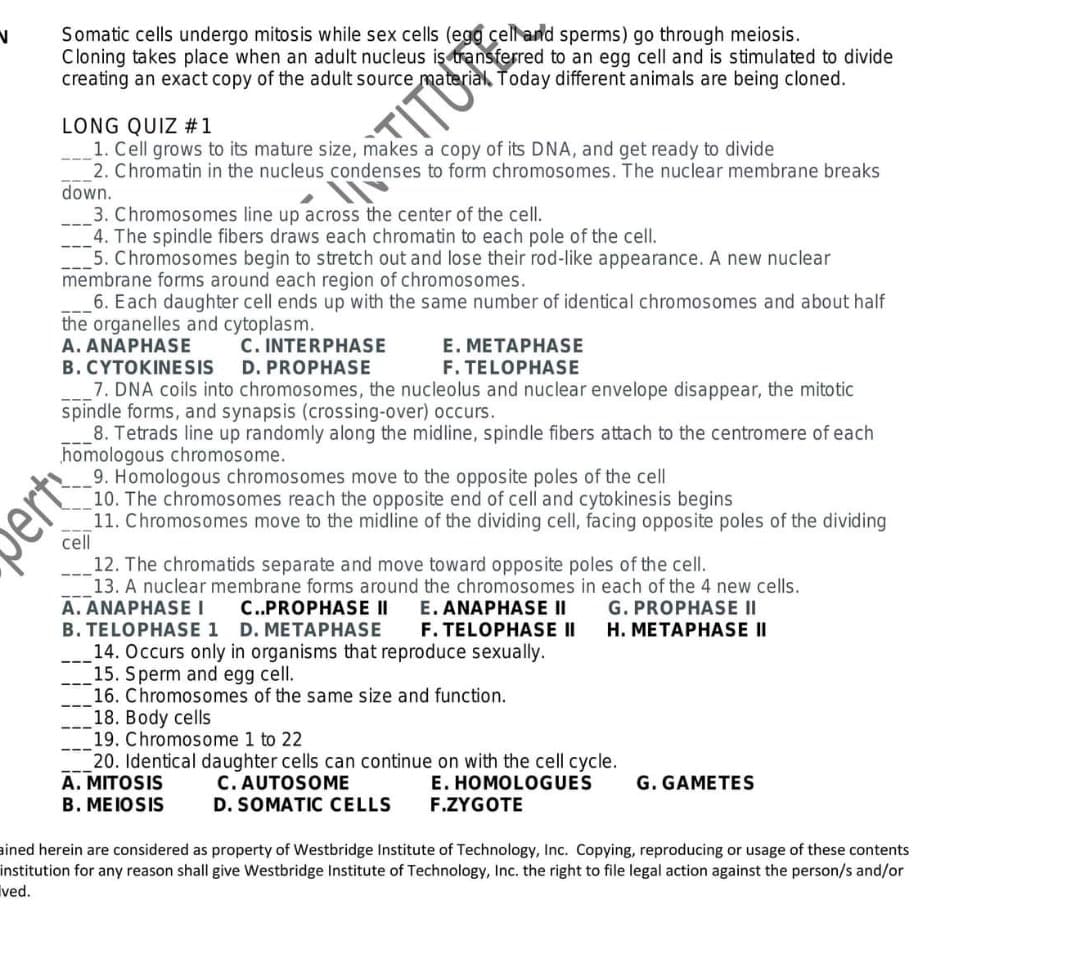1. Cell grows to its mature size, makes a copy of its DNA, and get ready to divide 2. Chromatin in the nucleus condenses to form chromosomes. The nuclear membrane bre down. 3. Chromosomes line up across the center of the cell. 4. The spindle fibers draws each chromatin to each pole of the cell. 5. Chromosomes begin to stretch out and lose their rod-like appearance. A new nuclear membrane forms around each region of chromosomes. 6. Each daughter cell ends up with the same number of identical chromosomes and about che organelles and cytoplasm. A. ANAPHASE C. INTERPHASE E. METAPHASE
1. Cell grows to its mature size, makes a copy of its DNA, and get ready to divide 2. Chromatin in the nucleus condenses to form chromosomes. The nuclear membrane bre down. 3. Chromosomes line up across the center of the cell. 4. The spindle fibers draws each chromatin to each pole of the cell. 5. Chromosomes begin to stretch out and lose their rod-like appearance. A new nuclear membrane forms around each region of chromosomes. 6. Each daughter cell ends up with the same number of identical chromosomes and about che organelles and cytoplasm. A. ANAPHASE C. INTERPHASE E. METAPHASE
Human Anatomy & Physiology (11th Edition)
11th Edition
ISBN:9780134580999
Author:Elaine N. Marieb, Katja N. Hoehn
Publisher:Elaine N. Marieb, Katja N. Hoehn
Chapter1: The Human Body: An Orientation
Section: Chapter Questions
Problem 1RQ: The correct sequence of levels forming the structural hierarchy is A. (a) organ, organ system,...
Related questions
Question

Transcribed Image Text:Somatic cells undergo mitosis while sex cells (egg çell and sperms) go through meiosis.
Cloning takes place when an adult nucleus iş transferred to an egg cell and is stimulated to divide
creating an exact copy of the adult source material, Today different animals are being cloned.
LONG QUIZ #1
1. Cell grows to its mature size, makes a copy of its DNA, and get ready to divide
2. Chromatin in the nucleus condenses to form chromosomes. The nuclear membrane breaks
down.
3. Chromosomes line up across the center of the cell.
4. The spindle fibers draws each chromatin to each pole of the cell.
5. Chromosomes begin to stretch out and lose their rod-like appearance. A new nuclear
membrane forms around each region of chromosomes.
6. Each daughter cell ends up with the same number of identical chromosomes and about half
the organelles and cytoplasm.
A. ANAPHASE
B. CYTOKINESIS
7. DNA coils into chromosomes, the nucleolus and nuclear envelope disappear, the mitotic
spindle forms, and synapsis (crossing-over) occurs.
8. Tetrads line up randomly along the midline, spindle fibers attach to the centromere of each
homologous chromosome.
9. Homologous chromosomes move to the opposite poles of the cell
10. The chromosomes reach the opposite end of cell and cytokinesis begins
11. Chromosomes move to the midline of the dividing cell, facing opposite poles of the dividing
cell
C. INTERPHASE
D. PROPHASE
E. METAPHASE
F. TELOPHASE
12. The chromatids separate and move toward opposite poles of the cell.
13. A nuclear membrane forms around the chromosomes in each of the 4 new cells.
A. ANAPHASE I
B. TELOPHASE 1 D. METAPHASE
14. Occurs only in organisms that reproduce sexually.
15. Sperm and egg cell.
16. Chromosomes of the same size and function.
18. Body cells
19. Chromosome 1 to 22
20. Identical daughter cells can continue on with the cell cycle.
A. MITOSIS
B. MEIOSIS
---
E. ANAPHASE II
F. TELOPHASE II
G. PROPHASE II
H. METAPHASE II
C..PROPHASE II
---
---
C. AUTOSOME
D. SOMATIC CELLS
E. HOMOLOGUES
F.ZYGOTE
G. GAMETES
ained herein are considered as property of Westbridge Institute of Technology, Inc. Copying, reproducing or usage of these contents
institution for any reason shall give Westbridge Institute of Technology, Inc. the right to file legal action against the person/s and/or
Ived.
ert
Expert Solution
This question has been solved!
Explore an expertly crafted, step-by-step solution for a thorough understanding of key concepts.
This is a popular solution!
Trending now
This is a popular solution!
Step by step
Solved in 2 steps

Recommended textbooks for you

Human Anatomy & Physiology (11th Edition)
Anatomy and Physiology
ISBN:
9780134580999
Author:
Elaine N. Marieb, Katja N. Hoehn
Publisher:
PEARSON

Anatomy & Physiology
Anatomy and Physiology
ISBN:
9781259398629
Author:
McKinley, Michael P., O'loughlin, Valerie Dean, Bidle, Theresa Stouter
Publisher:
Mcgraw Hill Education,

Human Anatomy
Anatomy and Physiology
ISBN:
9780135168059
Author:
Marieb, Elaine Nicpon, Brady, Patricia, Mallatt, Jon
Publisher:
Pearson Education, Inc.,

Human Anatomy & Physiology (11th Edition)
Anatomy and Physiology
ISBN:
9780134580999
Author:
Elaine N. Marieb, Katja N. Hoehn
Publisher:
PEARSON

Anatomy & Physiology
Anatomy and Physiology
ISBN:
9781259398629
Author:
McKinley, Michael P., O'loughlin, Valerie Dean, Bidle, Theresa Stouter
Publisher:
Mcgraw Hill Education,

Human Anatomy
Anatomy and Physiology
ISBN:
9780135168059
Author:
Marieb, Elaine Nicpon, Brady, Patricia, Mallatt, Jon
Publisher:
Pearson Education, Inc.,

Anatomy & Physiology: An Integrative Approach
Anatomy and Physiology
ISBN:
9780078024283
Author:
Michael McKinley Dr., Valerie O'Loughlin, Theresa Bidle
Publisher:
McGraw-Hill Education

Human Anatomy & Physiology (Marieb, Human Anatomy…
Anatomy and Physiology
ISBN:
9780321927040
Author:
Elaine N. Marieb, Katja Hoehn
Publisher:
PEARSON